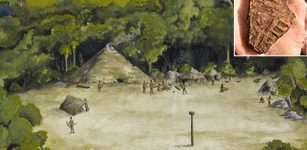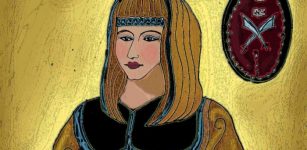Saint George: Knight Warrior Who Refused To Denounce His Faith And Died A Martyrs Death
A. Sutherland - AncientPages.com - Although the historical authenticity of St. George’s existence has long been a subject of controversy, he remains an important figure in the history of faith, in history in general, and above all - in legends.
Saint George was born in the third century in Cappadocia, Turkey, died on April 23, about 303 in Lydda (now Lod in Israel).
 Saint George's monument in Tbilisi, Georgia. Image credit: Haakon S. Krohn - CC BY-SA 3.0
Saint George's monument in Tbilisi, Georgia. Image credit: Haakon S. Krohn - CC BY-SA 3.0
Sources vary regarding his birthplace; two popular versions mention Coventry (in England) and Cappadocia in Turkey, where his father came from. According to the oldest preserved version of the legend, dating from the 10th century, George was born in a noble family: one of his grandparents was the governor of Cappadocia, and the other was the duke of Lydda. As a widow, his mother returned with George to her city and provided him with education.
Already at a young age, he followed his father's example, exhibiting military talents. Immediately after reaching the age of 18, George volunteered to join the Roman legions and soon came to the rank of a senior officer in the Roman army, commanding five thousand soldiers.
A Knight On A White Horse
The traditional depictions of George are based on his most famous deed - the killing of the dragon.
He is shown as a knight riding a white horse and dressed in a short tunic, often bearing a lance tipped by a cross and killing a dragon.
His other attributes included a horse, an angel with a laurel wreath or with a crown, a lamb, a white banner or a lance with a red cross, the Martyr's Palm.
There were many places dedicated to his worship; he patronized religious orders, cities and entire countries.
Persecution Of Christians
In 303, Roman Emperor Diocletian (244-311 AD) issued an edict allowing the persecution of Christians within the empire. The so-called Diocletianic Persecution (303–312), - the empire's last, largest, and bloodiest official harassment of Christianity - eventually, failed to eliminate Christianity in the empire.
Although he was a Christian himself, George was forced to participate in persecutions, but he refused to sacrifice to Roman deities. He distributed all his possessions to the poor, openly criticized the edict of Diocletian, and tore off the anti-Christian edict from the walls of Nicomedia. For these actions, he was punished severely. He was subjected to extremely cruel and long agonies.
He was nailed to the cross, tortured on the wheel, and finally beheaded under the city walls of Nicomedia (now Izmit, in Turkey) on 23 April 303.
Alexandra of Rome, the reputed wife of Emperor Diocletian who also secretly converted to Christianity, joined George in martyrdom as well. George's body was transported to Lydda (under Byzantine times called Diospolis, now Lod, Israel), where he was buried.
St. George And The Dragon
The history of St. George was described, among others by an Italian chronicler and archbishop of Genoa, Jakub de Voragine around 1260, in the "Golden Legend" (also known as Legenda Aurea).
 Miniature from a 13th-century Passio Sancti Georgii (Verona) source: Public Domain
Miniature from a 13th-century Passio Sancti Georgii (Verona) source: Public Domain
The versions of the legend vary a lot. One says that at the water source that supplied the city of Silene (probably later Cyrena in Libya), a horrible dragon made its nest. Trying to keep it away from the town, the citizens drew lots to decide whom among the youngest in town to sacrifice to the monster. One day, the daughter of the king had to be the dragon’s next offer.
The monarch begged for her life, but his attempts were in vain. Just before she was sacrificed to the dragon, St. George appears riding his horse and he manages to neutralize the dragon (this scene was many times immortalized by artists).
St. George – Patron Of Many Regions, Cities And Countries
Saint George is the patron of many countries, including England, Georgia, Portugal, the Netherlands, Germany, Sweden, Lithuania, Russia, Bosnia, Serbia, Montenegro, and Ethiopia, patron of Palestinian Christians.
He is also a patron of many cities and regions and many brotherhoods, religious congregations, and orders of knights were founded under the invocation of St. George, including the Order of Saint George from Carinthia, Order of Saint George from Alfama. Saint George is also a patron of knights, wanderers, miners, soldiers, blacksmiths, coopers, artists, prisoners, and scouts.
As a national saint in England, he continued even after his death to give hope and comfort to people in need.
The image of Saint George, a knight on a horse, killing a dragon, is known to almost every European. No doubt, this legendary figure is one of the most important symbols of the Christian world.
His memorial day is celebrated in most countries on April 23.
Written by – A. Sutherland - AncientPages.com Senior Staff Writer
Copyright © AncientPages.com All rights reserved. This material may not be published, broadcast, rewritten or redistributed in whole or part without the express written permission of AncientPages.com
More From Ancient Pages
-
 Unraveling The Secret History Of King Arthur And Robin Hood
Featured Stories | Jul 14, 2015
Unraveling The Secret History Of King Arthur And Robin Hood
Featured Stories | Jul 14, 2015 -
 America’s First Casino Was Created By The Promontory Culture 700 Years Ago
Ancient History Facts | Apr 30, 2016
America’s First Casino Was Created By The Promontory Culture 700 Years Ago
Ancient History Facts | Apr 30, 2016 -
 Uncovering The Lost Indigenous Settlement Of Sarabay, Florida
Archaeology | Jun 9, 2021
Uncovering The Lost Indigenous Settlement Of Sarabay, Florida
Archaeology | Jun 9, 2021 -
 Saraswati – Hindu Goddess Of Knowledge, Learning And Vedic Symbol Of Speech, Vach
Featured Stories | Jun 23, 2021
Saraswati – Hindu Goddess Of Knowledge, Learning And Vedic Symbol Of Speech, Vach
Featured Stories | Jun 23, 2021 -
 Chinampas: Artificial Islands Created By The Aztecs To Improve Agriculture
Ancient History Facts | May 17, 2016
Chinampas: Artificial Islands Created By The Aztecs To Improve Agriculture
Ancient History Facts | May 17, 2016 -
 Mysterious Dark Watchers – One Of America’s Greatest Ancient Riddles
Featured Stories | Nov 13, 2014
Mysterious Dark Watchers – One Of America’s Greatest Ancient Riddles
Featured Stories | Nov 13, 2014 -
 Long-Standing Mystery Of What May Have Triggered Ice Age Solved – New Study
Archaeology | Jun 24, 2022
Long-Standing Mystery Of What May Have Triggered Ice Age Solved – New Study
Archaeology | Jun 24, 2022 -
 On This Day In History: Soviet Spacecraft Venera 7 Launched: First To Send Data From Venus To Earth – On Aug 17, 1970
News | Aug 17, 2016
On This Day In History: Soviet Spacecraft Venera 7 Launched: First To Send Data From Venus To Earth – On Aug 17, 1970
News | Aug 17, 2016 -
 Intriguing Ptolemaic And Roman Treasures Unearthed In Al Bahnasa, Egypt
Archaeology | Jan 10, 2024
Intriguing Ptolemaic And Roman Treasures Unearthed In Al Bahnasa, Egypt
Archaeology | Jan 10, 2024 -
 Posca: ‘Wine Of The People’ Was Popular In Ancient Rome And Greece
Ancient History Facts | Sep 26, 2018
Posca: ‘Wine Of The People’ Was Popular In Ancient Rome And Greece
Ancient History Facts | Sep 26, 2018 -
 Ancient Irrigation System Could Boost Water Availability In Peru
Archaeology | Jun 26, 2019
Ancient Irrigation System Could Boost Water Availability In Peru
Archaeology | Jun 26, 2019 -
 Female Viking Pirate Rusla – The Red Maiden’s Deadly Encounter With Her Brother Tesondus
Featured Stories | Jul 2, 2019
Female Viking Pirate Rusla – The Red Maiden’s Deadly Encounter With Her Brother Tesondus
Featured Stories | Jul 2, 2019 -
 Rare Roman Mosaic Of Amazon Warriors Unearthed In Syria Hailed As Major Archaeological Discovery
Archaeology | Oct 12, 2022
Rare Roman Mosaic Of Amazon Warriors Unearthed In Syria Hailed As Major Archaeological Discovery
Archaeology | Oct 12, 2022 -
 History Shows: Taxes And Bureaucracy Are Cornerstones Of Democracy
Archaeology | Feb 18, 2021
History Shows: Taxes And Bureaucracy Are Cornerstones Of Democracy
Archaeology | Feb 18, 2021 -
 Pharaoh Hatshepsut: Skillful And Efficient Female Ruler Who Brought Prosperity To Ancient Egypt
Featured Stories | Mar 22, 2017
Pharaoh Hatshepsut: Skillful And Efficient Female Ruler Who Brought Prosperity To Ancient Egypt
Featured Stories | Mar 22, 2017 -
 Cooper’s Ferry Site In Western Idaho Was Inhabited 16,000 Years Ago
Archaeology | Sep 3, 2019
Cooper’s Ferry Site In Western Idaho Was Inhabited 16,000 Years Ago
Archaeology | Sep 3, 2019 -
 Sayyida Al Hurra – Feared And Respected Pirate Queen Of Morocco Had No-One To Turn At The End
Featured Stories | Mar 11, 2019
Sayyida Al Hurra – Feared And Respected Pirate Queen Of Morocco Had No-One To Turn At The End
Featured Stories | Mar 11, 2019 -
 Thermopolium – Ancient Roman Restaurant Offered Fast Food But Was It A Good Idea To Eat There?
Ancient History Facts | Mar 16, 2018
Thermopolium – Ancient Roman Restaurant Offered Fast Food But Was It A Good Idea To Eat There?
Ancient History Facts | Mar 16, 2018 -
 Pharos Of Alexandria – One Of The First Lighthouses In The Ancient World
Featured Stories | Sep 1, 2015
Pharos Of Alexandria – One Of The First Lighthouses In The Ancient World
Featured Stories | Sep 1, 2015 -
 First Kisses May Have Helped Spread Oral Herpes 5,000 Years Ago – Scientists Say
Archaeology | Jul 30, 2022
First Kisses May Have Helped Spread Oral Herpes 5,000 Years Ago – Scientists Say
Archaeology | Jul 30, 2022
